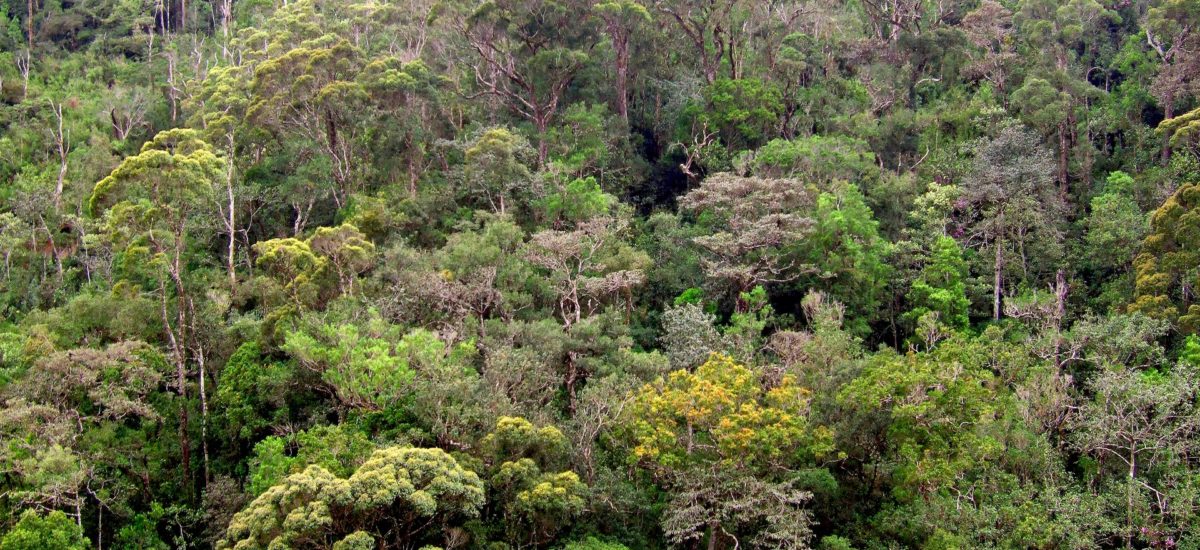Photo courtesy of Dinarzarde Raheem
Circular MWFC/1/20201 issued on 4 November by the Ministry of Wildlife and Forest Conservation has caused widespread concern and consternation. This circular seeks to make all Sri Lanka’s other state forests (OSFs) available for “economic and other productive activities” [my translation]. It does so by revoking four previous circulars (5/2001, 02/2006, 02/02/03/301 and 05/98) and by transferring the administration of OSFs from the Forest Department to district and divisional secretariats. As reported widely in the media since earlier this year, conservationists, researchers and environmental lawyers fear that the release of OSFs for economic and other activities will lead to their clearance and destruction. Some media reports assert that more than 700,000 ha of forest could be at stake2,3. The potential consequences for the conservation of Sri Lanka’s biodiversity are grave. Particularly at risk are the highly threatened natural forests of the Wet and Intermediate Zones. As a field biologist, who for much of the last three decades has explored the forests of these two climatic zones, I have seen or carried out field research in a substantial number of OSFs. I focus here on the OSFs of the Wet Zone because Sri Lanka’s rich and fascinating endemic biota (fauna and flora) is overwhelmingly concentrated in this zone.
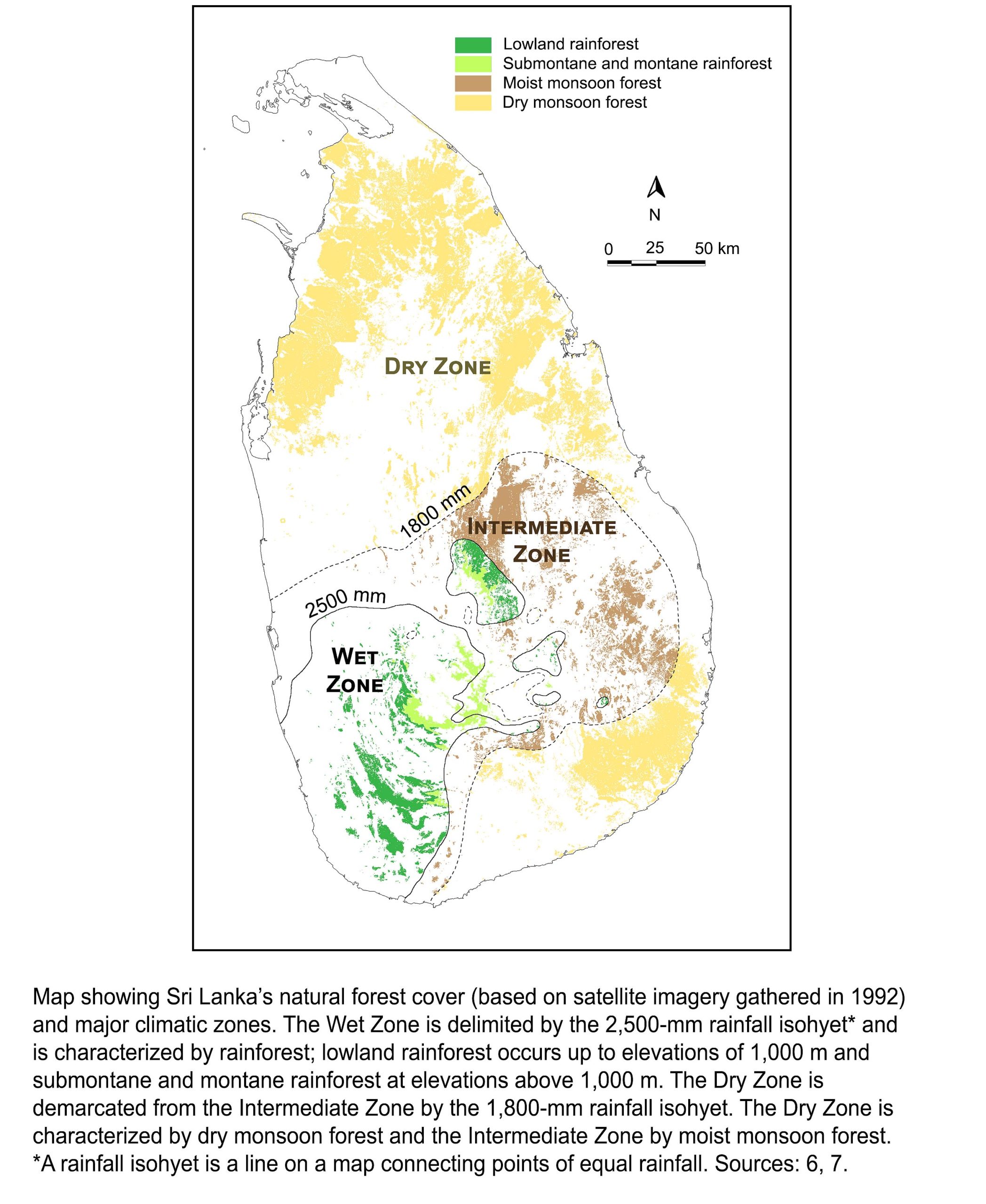
Global importance of Sri Lanka’s biodiversity
Sri Lanka’s biota is globally important because of the large number of endemic species (species unique to the island) that are concentrated in the rainforests of the wet, southwestern portion of the island, the so-called Wet Zone. These forests contain 94% of the 830 flowering-plant species endemic to the island4 and more than 80% of the island’s approximately 200 endemic land mollusc species5. The Wet Zone covers about 13,000 km2, that is less than 20% of the total area of the island6,7. Remarkably, many Sri Lankan endemic species are not only confined to the Wet Zone, they are unique to small or geographically-restricted parts of this zone. Such species can be referred to as Wet Zone microendemics, species that are found in small, restricted parts of the Wet Zone and nowhere else on Earth. The genus Stemonoporus, which is endemic to Sri Lanka and a member of the rainforest tree family Dipterocarpaceae, is a striking example. There are more than 20 species in this genus and most of these are microendemics of the Wet Zone8. Botanists Peter Ashton and Savitri Gunatilleke in an influential 1987 paper9 on the evolutionary origins and distribution of Sri Lanka’s flora highlighted that in the sheer concentration of plant microendemics no other similar-sized area in Asia surpasses the Wet Zone. Some Sri Lankan animal groups, such as amphibians and land molluscs, also contain many Wet Zone microendemic species. One of the most spectacular examples of microendemism on the island is the shrub frog genus Pseudophilautus, which is represented by 79 species in Sri Lanka (52 living and 17 extinct species), all endemic to the island10. Most of these species are endemic to specific parts of the Wet Zone, with 25 species being restricted to either Adam’s Peak, the Knuckles or the Rakwana hills10.
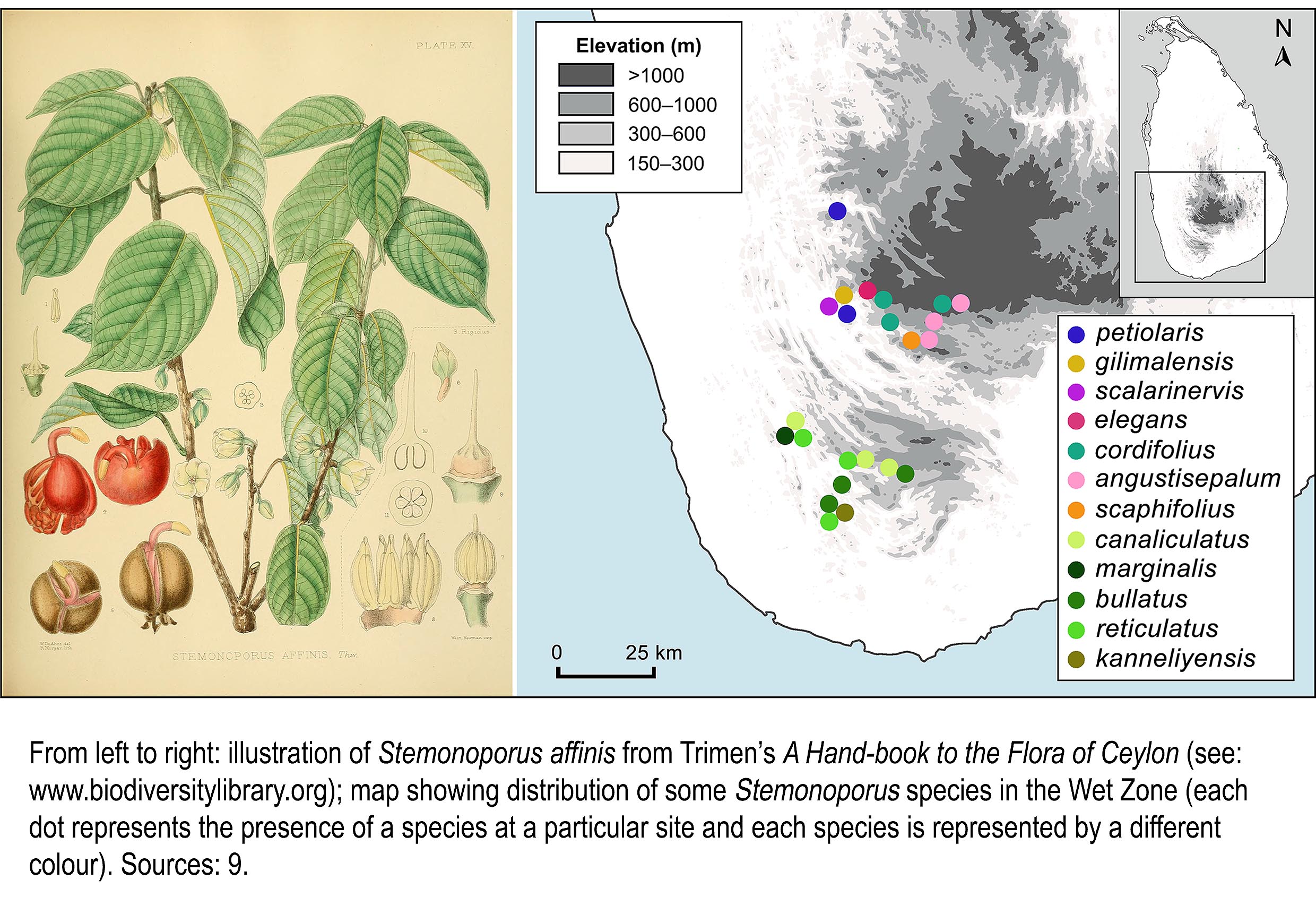
Like in other parts of the tropics, Sri Lanka’s forest-living species are largely or entirely dependent on natural forest for their survival and are highly threatened because of drastic habitat loss. This is why Sri Lanka, together with India’s Western Ghats, has been included as one of the 36 global biodiversity hotspots recognized by Conservation International. These hotspots are biologically rich but highly threatened: they harbour more than half of Earth’s plant species as endemics, in just 2.4% of the planet’s land surface. The 36 hotspots also harbour more than 2 billion people, that is about 25% of the world’s human population. The Western Ghats and Sri Lanka hotspot is the third most densely populated of the hotspots (the average population density in 201511 was 335 people per km2), and its biodiversity is particularly at risk due to human-driven environmental change12.
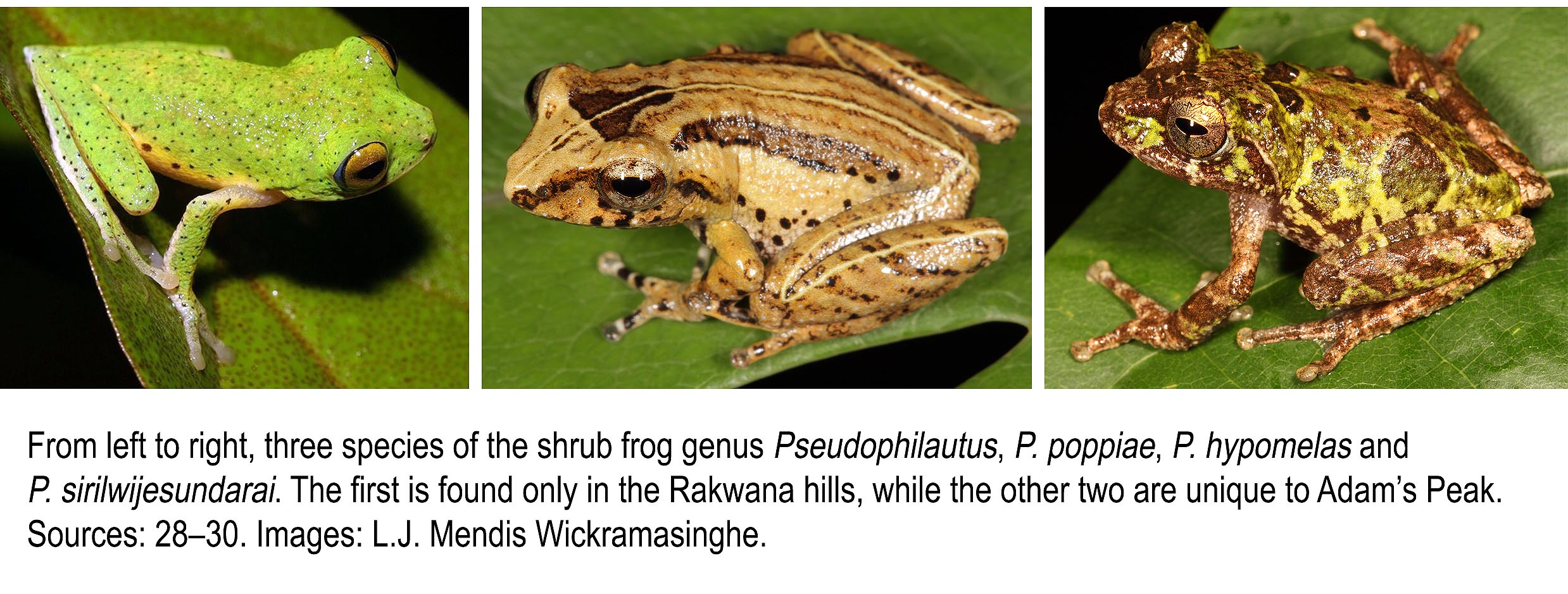
Conservation status of Sri Lanka’s rainforests
The most reliable source for recent forest cover data is a Forest Department mapping project6,7 that ran from 1991–1995. Based on detailed satellite imagery of the whole island, this showed that Sri Lanka’s closed-canopy natural forest cover accounted for just 24% (15,828 km2) of the total land area in 1992; when sparse and open forest, and forest plantations (e.g. pine and Eucalyptus) were included, the total extent of forest cover for the island was 32% (21, 189 km2)7 (in comparison forest cover stood at about 84% in 1881 and at about 44% in 195613). Subsequent evaluations by the Forest Department for the Food and Agriculture Organization’s (FAO) Global Forest Resources Assessment14–16 have indicated a small decline in forest cover since the 1990s, with total forest cover estimated as 31% (20,350 km2) in 2000 and 30% in both 2010 (19,780 km2) and 2020 (19,660 km2). These evaluations, however, have been overly reliant on inferring forest cover data from trends in data collected and estimated in the past. For example, the annual rate of change in forest cover for the 1996–2010 period was used to estimate the forest cover for the years 2015–202016. Moreover, estimates of the extent of closed-canopy natural forest—most forest-living species critically depend on this type of forest—are not included. The forest cover data presented in the 2010–2020 FAO assessments for Sri Lanka, therefore, are incomplete and have to be treated with caution. There has been considerable expansion of settlements, agricultural lands and roads over the last 25 years, so it does seem likely that the scale of forest cover loss has been underestimated.
As elsewhere in the forested tropics, forest clearance has led not just to the decline of forest cover but to forest fragmentation. The latter involves the disintegration of large continuous forest tracts into many smaller forest islands or fragments that are isolated from each other by non-forest habitat, such as agriculture, roads and settlements17. It is in the Wet Zone that forest loss and fragmentation has been greatest6,7. Over the last two centuries, the largely continuous expanse of rainforest that extended over most of the Wet Zone has been reduced to numerous smaller, isolated fragments. In 1992 just 2,135 km2 of rainforest remained (13% of the island’s remaining natural forest) and this was distributed across numerous isolated patches or fragments, with few exceeding 50 km2 (5,000 ha) in extent6,7. Piecemeal clearance of forest has continued unabated over the last 25 years, so has almost certainly caused further habitat loss and fragmentation.
The Wet Zone’s remaining rainforest fragments, almost without exception, are confined to the higher slopes of hills or to rugged terrain in the interior of this zone, all the forest in the intervening river valleys and lower slopes having been replaced by permanent cultivation, roads and settlements18. In the lowlands (elevations below 1,000 m) of the Wet Zone, the remaining rainforests are nearly all secondary and highly degraded due to past intensive selective logging by the state18. The remaining submontane and montane rainforests are less disturbed but substantial areas have been affected by forest dieback (canopy loss due to the death or loss of vigour of stands of trees), the causes of which are uncertain19. In the Wet Zone, primary forest (forest not obviously altered by shifting cultivation and/or selective logging20) occurs only as small and scattered patches in a few of the larger, less accessible fragments and on the crests of isolated hills18,21.

The distributions of Sri Lanka’s rainforest species have declined greatly over the last two centuries. However, some species have declined more than others. One important reason for this is regional variation in the amount of forest loss7. In some regions, there is hardly any natural forest remaining (for example, see Google Earth satellite imagery), so species restricted to these areas are particularly at risk of extinction. A particularly stark example is the Upper Uva, the region comprising the Uva Basin (roughly the plateau in and around Bandarawela, Welimada and Badulla) and the high ridges and peaks to the north (Uda Pussellawa and Narangala), east (Namunukula and Madulseema) and south (Haputale–Idalgashinna). Rainforest cover was extensive in this region in the early 19thcentury but is now restricted to a few small, isolated and highly degraded patches on the crests of hills and on steep hillsides. The surrounding non-forest habitats consist of intensive agriculture in the form of tea, vegetable crops and rice paddy; home gardens; monoculture forest plantations (mainly pine and Eucalyptus); and open grassland. At under 300 ha, the forest on the summit of the Namunukula ridge is by far the largest remaining fragment of rainforest in the region4,6,7.
OSFs defined
Virtually all of Sri Lanka’s forest cover is owned by the state and this has been the case since the British colonial period13. These forests fall into two major classes, those that are legally designated and those that are not. Broadly speaking, the legal designation of a forest involves the legal demarcation of its boundaries and the enactment of specific legal provisions to ensure its conservation (e.g. restrictions on access)4,22. Sri Lanka’s legally-designated forests (collectively known as its protected areas network) consist of areas under the jurisdiction of the Department of Wildlife Conservation (DWC) and the Forest Department. The legally-designated areas under the DWC are national parks (NPs), nature reserves (NRs), strict nature reserves (SNRs) and sanctuaries; those areas under the Forest Department are forest reserves (FRs), conservation forests (CFs) and one national heritage wilderness area (NHWA)4,22,23.

Most of the natural forest area that is not legally designated consists of OSFs and proposed reserves (PRs). OSFs have been under the oversight of the Forest Department in recent decades, but prior to that were from time to time administered by the relevant government agents13. In both the Wet and Intermediate Zones, OSFs occur on steep, rocky and/or inaccessible terrain, making them largely unsuitable for agriculture, and that has been a major factor in why these forests have remained intact so far. They vary greatly in size and quality, ranging from small, often heavily degraded patches (100 ha or less) to substantial areas of forest extending over several thousand hectares4. PRs are essentially OSFs that are administered by the Forest Department as forest reserves; these areas were earmarked for notification as forest reserves, but legal demarcation of boundaries never took place4,22.
The National Conservation Review and OSFs
Much of what is currently known about the biodiversity of OSFs comes from a trail-blazing FAO-funded project that was carried out in the 1990s by the Forest Department in collaboration with the World Conservation Union (IUCN) and the World Conservation Monitoring Centre4,22. Known as the National Conservation Review (NCR), this sought to define a national system of forests for biodiversity conservation and watershed protection. Over the 5.5. years of the project, 204 forests were surveyed from all regions of the island, apart from the north and the east, which were then inaccessible because of the war. The primary focus of these surveys was on the exhaustive surveying of woody plants, but vertebrates, molluscs and butterflies were also included. A total of 281 forests were evaluated for their importance for watershed protection (i.e. soil erosion, headwaters protection, flood hazard and fog interception).
The findings of the NCR, which were presented in a hefty two-volume report that appeared in 199722, showed that the Wet Zone’s remaining rainforests were vital either for biodiversity conservation or watershed protection. A minimum network of 104 individual forest fragments, covering 516,795 ha or 7.8% of the total area of the island, was identified as being essential for watershed protection and biodiversity conservation. Apart from a few small fragments, this system includes virtually all of the Wet Zone’s rainforests, with 65% of the 104 forests being either OSFs or PRs (35% and 30%, respectively). The NCR stressed that every effort should be made to protect these forests and highlighted the uncertain and tenuous legal status of much of the forest under the jurisdiction of the Forest Department. The NCR also drew attention to the need for future surveys that would provide data on other elements of the Sri Lankan biota and for forests that had been poorly surveyed or not surveyed at all, such as those in the island’s north and east. Sadly, these recommendations have largely been ignored by successive governments.
OSFs and the conservation of Sri Lanka’s endemic biota
OSFs are important for conserving the endemic biota because collectively they comprise a substantial part of the island’s highly threatened rainforests. To put it another way, so little forest cover remains in the Wet Zone today that all of it is required if we are to conserve the island’s biological diversity and protect its watersheds. This point was clearly underlined on page iv of the NCR’s Final Report22: “Given that there is very little redundancy in the wet zone, forests being important for either woody plants, animals or for protection of watersheds, every effort should be made to conserve remaining natural forest and maintain the current ban on logging in the wet zone for the foreseeable future.”
OSFs serve at least two vital functions for the conservation of Sri Lanka’s Wet Zone biota. First, OSFs enhance the extent to which all the forest fragments in a landscape are physically connected or joined up, a property which ecologists refer to as connectivity. In the most extensively forested landscapes of the Wet Zone, OSFs increase connectivity by serving as habitat corridors or stepping stones between larger (protected) forest areas, providing important additional habitat for forest-living species to disperse through and to utilize for food and shelter. They also act as buffer zones, strengthening and protecting the margins of protected areas.
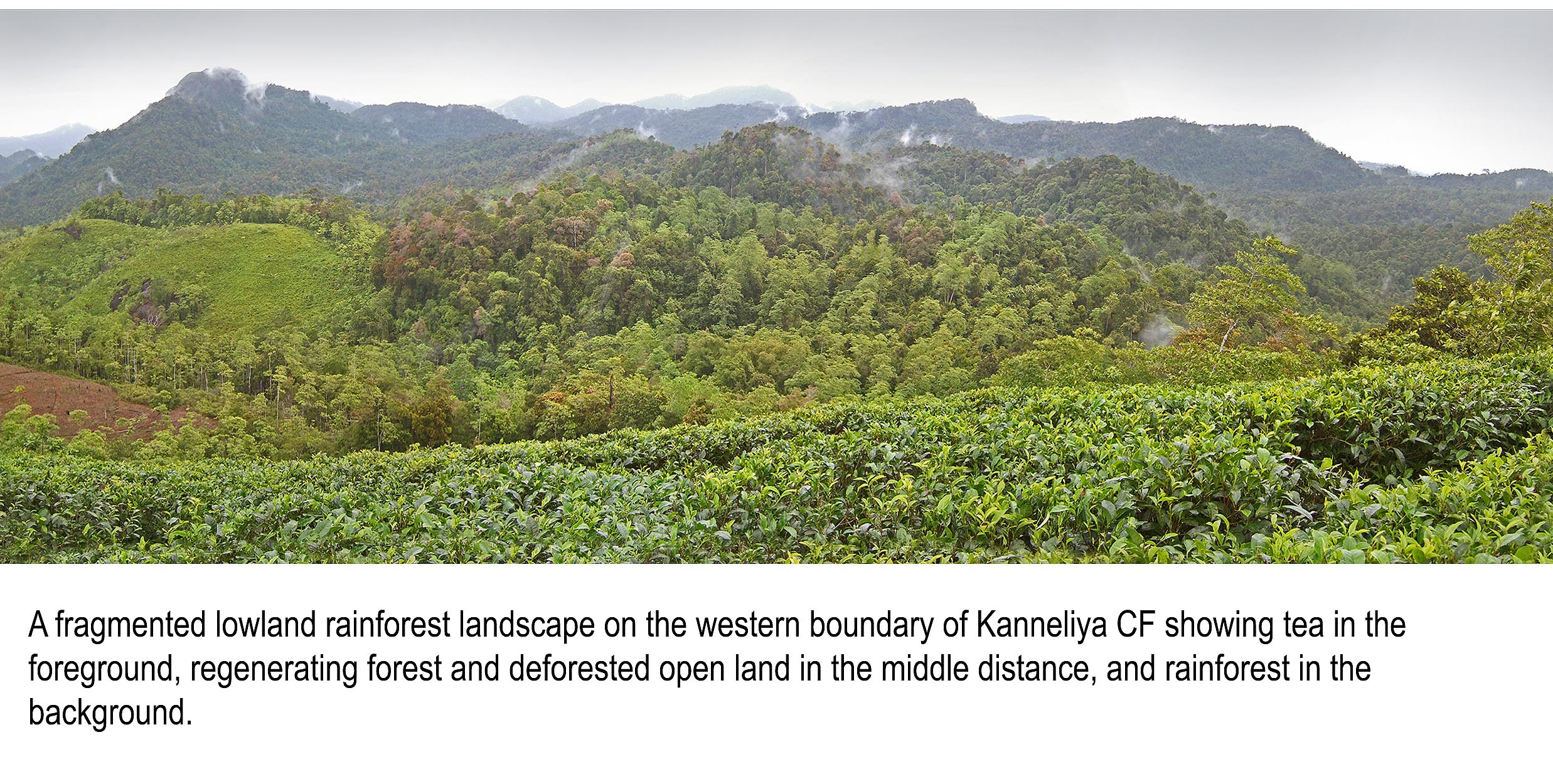
Second, OSFs serve as habitat refugia. A refugium is a habitat remnant of limited extent that supports a biota that was formerly more widespread but because of disturbance (in this case deforestation) is now restricted to that remnant24. In some of the most heavily deforested parts of the Wet Zone, the remaining forest is confined to small, isolated and highly degraded patches that are surrounded by a sea of settled and cultivated land, the latter usually consisting of large swathes of intensive monocultures, such as tea, rubber, coconut, oil palm or vegetables. In such landscapes, OSFs constitute a substantial part of the remaining forest and are thus among the last refuges for forest-living species. While the protection of these refugia are critical, the severity of forest fragmentation is so great that the functioning of ecological processes essential for the long-term survival of forest species (e.g. pollination, seed dispersal and forest regeneration) may have been greatly impaired. In these heavily deforested landscapes, if we are to conserve both forest species and ecological processes, reforestation efforts are absolutely vital. This is underlined by a review published this year in the leading ecological journal Ecology Letters—this concluded that at least 40% of a given forested landscape should be maintained as natural forest to ensure the survival of most of the forest species inhabiting that landscape25.
Although I have focussed here on the Wet Zone, the forests of the Intermediate Zone provide important additional habitat for endemic species and contain distinctive plant and animal communities (a biological community refers to all the species present in a particular place at a particular time). A number of these form part of the minimum network of 104 forest areas identified by the NCR as being essential for watershed protection and biodiversity conservation22. Numerous forested hills are scattered across the part of the southeastern Intermediate Zone that lies between the towns of Moneragala, Bibile, Maha Oya and Nilgala. These forests, many of which are OSFs4, are of major conservation importance because they contain some of the most pristine areas of forest remaining in Sri Lanka today. Moreover, the biota of these forests, particularly the fauna, has been poorly explored. The recent discovery of a new species of the endemic frog genus Nannophrys26 highlights that species new to science remain to be discovered in this region.
OSFs: threats and conservation
While section 2 of circular MWFC/1/2020 states that the purpose of transferring OSFs to district and divisional secretariats is to make them available for “economic and other productive activities”, it provides no details on what these productive activities might be. It is also noteworthy that section 4 of the circular details ten land-use categories exempted from utilization. These include areas important for the protection of endangered fauna and flora, rivers and streams, areas with steep gradients, and catchments areas. Nearly all of the Wet Zone forests fall into one or more of these categories (for example, as shown by the NCR), so the lack of specific provisions in the circular to retain the OSFs of the Wet Zone under the administration of the Forest Department is a major oversight.
The removal of OSFs from the administrative control of the Forest Department coupled with the absence of any other legal protection for OSFs has substantially increased the likelihood that these forests will be exploited for agriculture, settlement and/or the value of the standing timber. The risk that these forests will be cleared and destroyed is, arguably, far greater now than at any time in recent decades. The OSFs of the Wet Zone are particularly at risk because they occur in the most densely inhabited parts of the island27, where pressures on land are severe. The destruction of these forests is likely to have disastrous consequences on the biota and ecology of the Wet Zone’s rainforests. It will cause further decline of endemic rainforest species and may cause species extinctions. It will almost certainly further damage the ecological processes that maintain forest-living plant and animal communities. The clearance of OSFs may also adversely affect water availability; increase soil erosion, leading to the increased occurrence of landslides and flooding; and have negative impacts on local climate.
The challenges we face in conserving Sri Lanka’s rainforests, both protected areas and OSFs, are hugely complex. These forests are profoundly affected by the human settlements, agriculture and roads that surround them. The challenge is to manage these forests as part of the wider human-dominated landscapes in which they are located and not as isolated units. This critically rests on restoring and managing connectivity between forest fragments, with fragments being linked to each other by forest corridors, buffer zones, narrow vegetation strips and biodiversity-friendly agroforests. Another significant challenge is to recognize that for conservation to succeed, local people have to play a significant role; it is they who are best placed to take a leading role in conservation and who should draw tangible benefits from it. While these challenges have to be tackled as a matter of urgency, there is no simple solution. A whole raft of different measures are required and I touch upon a few below. Many of these measures are broadly applicable to the natural forests of the Intermediate and Dry Zones, but additional measures will be required, particularly with regard to the conservation of large mammals, such as the Asian elephant and Sri Lankan leopard. The natural forests of much of the Intermediate and Dry Zones, including all of the north and east, still remain to be surveyed in detail for their biodiversity and soil conservation value (i.e. using approaches comparable to the NCR), and this requires urgent attention.
In the Wet Zone, a high priority is to upgrade the legal status of OSFs and PRs; the current crisis underscores the importance of adequate legal protection for conservation areas. While habitat protection is critical, it is only a first step. Crucially, effective measures have to be taken to reduce/halt the clearance of natural forest. One stop-gap option might be to release suitable non-forest lands from large-scale commercial plantations and state bodies, such as the Land Reform Commission. However, land is a finite resource and when used for meeting human needs should be managed carefully and effectively. A national land-use policy based on detailed and regular monitoring of land use across the country will be absolutely key to this. Other measures that could help reduce pressures on natural forest include improving agricultural productivity and diversifying rural economies. Concerted efforts should also be made to increase forest cover through reforestation. One way this could be achieved would be to allow forest to regenerate naturally on degraded lands bordering or occurring near natural forest areas. Another option would be to promote the cultivation of home gardens and other types of agroforests. Reforestation efforts of this kind will almost certainly require serious financial investment. Efforts to involve local people in conservation must ensure that a substantial part of tourism revenue from protected areas (e.g. Horton Plain NP, Sinharaja NHWA, Knuckles CF and Peak Wilderness Sanctuary) is invested in surrounding communities. It is also important that research on these various aspects of conservation, as well as on Sri Lanka’s biota is actively fostered and supported. Much of Sri Lanka’s rainforest biota remains unknown or poorly studied, and data on the ecology and evolutionary history of most rainforest species are scarce or lacking.
Political vision and commitment are required to bring about transformative changes of this kind—that is the need of the hour. Instead, with the introduction of circular MWFC/1/2020, we now appear to be headed on a very different trajectory, one that could set back biodiversity conservation by many decades. The future of Sri Lanka’s unique and irreplaceable rainforest biota has never been more uncertain.
References & Notes
1.Ministry of Wildlife and Forest Conservation. 2020. Cabinet circular no: MWFC/1/2020. Management of other state forests. 4 November 2020. [In Sinhala]. http://msdw.gov.lk/downloads/circulars/. 2. de Soysa, M. 2020. Groundviews, 9 Nov. 2020. https://groundviews.org/2020/11/09/sri-lanka-set-to-lose-more-forests/. 3. Ranawana, K. 2020. EconomyNext, 14 Nov. 2020. https://economynext.com/government-decision-disastrous-for-forests-and-biodiversity-environmentalists-75949/. 4. IUCN. 1993. Conservation review of some natural forests in Sri Lanka. Environmental Management in Forestry Development, Forest Department, Colombo. https://www.biodiversitylibrary.org/item/119259#page/1/mode/1up. 5. Naggs, F. & Raheem, D.C. 2000. Land snail diversity in Sri Lanka. Natural History Museum, UK. https://www.nhm.ac.uk/our-science/data/tropical-land-snails/taxa.dsml. 6. Legg, C. & Jewell, N. 1992. A new 1:50,000 scale forest map of Sri Lanka. Forest and Land Use Mapping project, Forest Department, Colombo. 7. Legg, C. & Jewell, N. 1995. Sri Lanka Forester, Special Issue (Remote Sensing): 3–24. 8. Gunatilleke, N. et al. 2017. Ceylon Journal of Science, 46, Special Issue: 65–78. https://cjs.sljol.info/articles/abstract/10.4038/cjs.v46i5.7454/. 9. Ashton, P.S. & Gunatilleke, C.V.S. 1987. Journal of Biogeography, 14: 249–285. https://doi.org/10.2307/2844895. 10. L.J. Mendis Wickramasinghe, personal communication. 11. Cunningham, C. & Beazley, K.F. 2018. Land, 7: 136. https://doi.org/10.3390/land7040136. 12. Cincotta, R.P. et al. 2000. Nature, 404: 990–992. https://doi.org/10.1038/35010105. 13. Baldwin, M.F. (ed.). 1991. Natural resources of Sri Lanka: conditions and trends. Natural Resources, Energy and Science Authority of Sri Lanka, Colombo. https://www.ircwash.org/resources/natural-resources-sri-lanka-conditions-and-trends. 14. FAO. 2010. Global forest resources assessment 2010. Country report: Sri Lanka. FAO, Rome, Italy. http://www.fao.org/forest-resources-assessment/past-assessments/fra-2010/country-reports/en/. 15. FAO. 2014. Global forest resources assessment 2010. Country report: Sri Lanka. FAO, Rome, Italy. http://www.fao.org/forest-resources-assessment/past-assessments/fra-2015/country-reports/en/. 16. FAO. 2020. Global forest resources assessment 2010. Country report: Sri Lanka. FAO, Rome, Italy. http://www.fao.org/forest-resources-assessment/fra-2020/country-reports/en/. 17. Döbert, T.F. et al. 2014. In: Global forest fragmentation (C.J. Kettle & L.P. Koh, eds.), pp. 28–49. CABI Publishing, Wallingford, UK. https://www.cabdirect.org/cabdirect/abstract/20143317939. 18. Raheem, D. 2005. Land-snail diversity in Sri Lankan rainforest fragments. PhD thesis, University of Cambridge, UK. 19. Pethiyagoda, R. 2012. Horton Plains: Sri Lanka’s cloud-forest national park. Wildlife Heritage Trust, Colombo. 20. Raheem, D.C. et al. 2009. Journal of Biogeography, 36: 1923–1938. https://doi.org/10.1111/j.1365-2699.2009.02136.x. 21. Werner, W. 1995. Sri Lanka’s magnificent cloud forests. Wildlife Heritage Trust, Colombo. 22. Green, M.J.B. & Gunawardena, E.R.N. 1997. Designing an optimum protected areas system for Sri Lanka’s natural forests. Volume 1. Environmental Management in Forestry Development Project, Forest Department, Government of Sri Lanka, Colombo. https://www.biodiversitylibrary.org/item/119149#page/12/mode/1up. 23. Government of Sri Lanka (GoSL). 2009. Forest (amendment) act, No. 65 of 2009. November 20, 2009. Department of Government Printing, Sri Lanka. 24. Keppel, G. et al. 2012. Global Ecology and Biogeography, 21: 393–404. https://doi.org/10.1111/j.1466-8238.2011.00686.x. 25. Arroyo‐Rodríguez, V. et al. 2020. Ecology Letters, 23: 1404–1420. https://doi.org/10.1111/ele.13535. 26. Fernando, S.S. et al. 2007. Zootaxa, 1403: 55–68. https://doi.org/10.11646/zootaxa.1403.1.3. 27. Department of Census and Statistics (DCS). 2015. Census of population and housing 2012: Final Report. Department of Census and Statistics, Sri Lanka. [In Sinhala]. http://www.statistics.gov.lk/Population/StaticalInformation/CPH2011. 28. Meegaskumbura, M. & Manamendra-Arachchi, K. 2005. Raffles Bulletin of Zoology, Supplement 12: 305–338. https://lkcnhm.nus.edu.sg/publications/raffles-bulletin-of-zoology/supplements/supplement-no-12/. 29. Wickramasinghe, L.J.M. et al.2013a. Journal of Threatened Taxa, 5: 181–5193. https://doi.org/10.11609/JoTT.o3547.5181-93. 30. Wickramasinghe, L.M. et al. 2013b. Journal Threatened Taxa, 5: 3789–3920. https://doi.org/10.11609/JoTT.o3099.3789-920.

